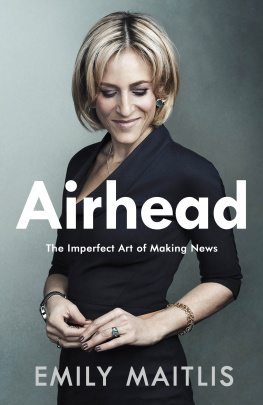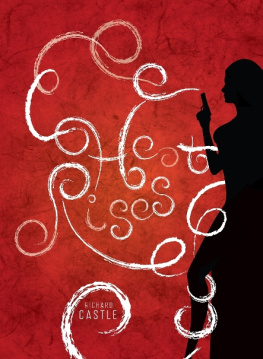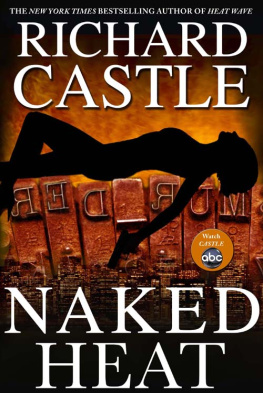Nikki Usher - Making News at The New York Times
Here you can read online Nikki Usher - Making News at The New York Times full text of the book (entire story) in english for free. Download pdf and epub, get meaning, cover and reviews about this ebook. year: 2018, publisher: The University of Michigan Press, genre: Politics. Description of the work, (preface) as well as reviews are available. Best literature library LitArk.com created for fans of good reading and offers a wide selection of genres:
Romance novel
Science fiction
Adventure
Detective
Science
History
Home and family
Prose
Art
Politics
Computer
Non-fiction
Religion
Business
Children
Humor
Choose a favorite category and find really read worthwhile books. Enjoy immersion in the world of imagination, feel the emotions of the characters or learn something new for yourself, make an fascinating discovery.
- Book:Making News at The New York Times
- Author:
- Publisher:The University of Michigan Press
- Genre:
- Year:2018
- Rating:4 / 5
- Favourites:Add to favourites
- Your mark:
- 80
- 1
- 2
- 3
- 4
- 5
Making News at The New York Times: summary, description and annotation
We offer to read an annotation, description, summary or preface (depends on what the author of the book "Making News at The New York Times" wrote himself). If you haven't found the necessary information about the book — write in the comments, we will try to find it.
Nikki Usher: author's other books
Who wrote Making News at The New York Times? Find out the surname, the name of the author of the book and a list of all author's works by series.
Making News at The New York Times — read online for free the complete book (whole text) full work
Below is the text of the book, divided by pages. System saving the place of the last page read, allows you to conveniently read the book "Making News at The New York Times" online for free, without having to search again every time where you left off. Put a bookmark, and you can go to the page where you finished reading at any time.
Font size:
Interval:
Bookmark:
 Page i Page ii
Page i Page ii Joseph Turow
SERIES EDITOR

Broadcasting, Voice, and Accountability: A Public Interest Approach to Policy, Law, and Regulation
Steve Buckley, Kreszentia Duer, Toby Mendel, and Sen Siochr, with Monroe E. Price and Marc Raboy
Owning the Olympics: Narratives of the New China
Monroe E. Price and Daniel Dayan, editors
The Hyperlinked Society: Questioning Connections in the Digital Age
Joseph Turow and Lokman Tsui, editors
When Media Are New: Understanding the Dynamics of New Media Adoption and Use
John Carey and Martin C. J. Elton
Making News at The New York Times
Nikki Usher
DIGITALCULTUREBOOKS, an imprint of the University of Michigan Press, is dedicated to publishing work in new media studies and the emerging field of digital humanities.
Page iiiNikki Usher
The University of Michigan Press
Ann Arbor
Copyright 2014 by Nikki Usher
All rights reserved
This book may not be reproduced, in whole or in part, including illustrations, in any form (beyond that copying permitted by Sections 107 and 108 of the U.S. Copyright Law and except by reviewers for the public press), without written permission from the publisher.
Published in the United States of America by
The University of Michigan Press
Manufactured in the United States of America Printed on acid-free paper
Printed on acid-free paper
2017 2016 2015 2014 4 3 2 1
A CIP catalog record for this book is available from the British Library.
ISBN 978-0-472-11936-3 (cloth : alk. paper)
ISBN 978-0-472-03596-0 (paper : alk. paper)
ISBN 978-0-472-12049-9 (e-book)
To Herbert Gans,
for his invaluable advice, wit, and wisdom
and for inspiring me to begin a journey
into the changing newsroom
- Page viii
This project would have been impossible without the unconditional support I received at the University of Southern California's Annenberg School of Communication and Journalism and at the George Washington University's School of Media and Public Affairs. I extend my deepest gratitude to my advisor, Larry Gross, for his support, advice, and critique. I also want to thank my dissertation committee, Henry Jenkins, Geneva Overholser, and Patti Riley, for their feedback and willingness to let me write a book instead of a traditional dissertation. Larry had me change hands and sent me to Joe Turow, a fantastic scholar, editor, and author at Annenberg Eastthe University of Pennsylvania's Annenberg School. Joe took this manuscript for his ambitious new series with the University of Michigan Press and provided incredible insight, editing, and trenchant support to get it into shape. I am incredibly lucky to have had him at my side. I also have been fortunate to have had the kind support of Tom Dwyer, past executive editor at the University of Michigan Press, who has been steadfastly supportive of my potential as a junior scholar.
I would also like to thank all of the many senior scholars who have helped me from graduate school to this point. In addition, having the chance to engage with Herbert Gans through years' worth of emails and far too few in-person meetings has been humbling and challenging. My cohort of junior scholars engaged in similar work have been astoundingly supportive, considering that we could be jealously at heads with each other. I particularly want to thank C.W. Anderson for our Page x friendship and his collegiality, and I would be at a loss without Matt Carlson, Seth Lewis, and Matt Powers and our regular email banter. The George Washington University's School of Media and Public Affairs has been encouraging throughout this process as I have moved from dissertation to book. I want to thank all my colleagues, especially Kim Gross, Frank Sesno, Steven Livingston, Bob Entman, and Catie Bailard. Kim, Frank, Silvio Waisbord, and Matt Hindman read various drafts of this book; Bob provided amazing advice about the publishing process, Silvio a chill pill. Matt challenged me and helped me think through some serious blocks, and I am lucky he was working on a new book as I began mine. Our colleague emeritus Jerry Manheim read much of this manuscript. All of my colleagues deserve thanks, and I expect our ties to deepen over the coming years. My dutiful research assistant Todd Kominiak read every word and formatted the document. And of course, deep gratitude goes to those who helped make sure I was housed and fed, and properly funded and reimbursed: Christine Lloreda at Annenberg and Maria Jackson at GWU.
Finally, special thanks to The New York Times and the business desk in particular. Larry Ingrassia and Bill Schmidt let me into the newsroom, and Kevin McKenna guided me while I was thereand answered any and all possible questions I might have. Special thanks to a few Times staffers who made my work so much fun: Tanzina Vega, Michael J. de la Merced, Mark Getzfred, Brian Stelter, Javier Hernandez, Eric Dash, and Kelly Couturier. Liz Alderman was the crucial link in my International Herald Tribune knowledge and in a visit to Paris, which was truly amazing. Many at The Times helped in so many ways, though of course all errors here are my own.
Thanks to all of my friends outside the walls of academia who have helped me through this processboth with the manuscript and with your kind support. And special thanks to my wife, Shelly Layser, who continues to be my inspiration. I couldn't ask for anything more in a life partner.
Page 1The new New York Times building that stands blocks away from its namesake Times Square is a fifty-two-story, Renzo Piano-designed office tower between Fortieth and Forty-first streets on Eighth Avenue. The ground floor of the building is dedicated to a New York Times auditorium, rented out for events and used by The Times for Times Talks, where New Yorkers have the chance to meet their favorite Times critic or other public intellectualor in some cases, a baseball player for the Yankees. The building itself is, as the leasing office proclaims, the first high rise curtain wall with ceramic sunscreen to be built in the United States. Practically, what this means is that the glass-walled building has light-sensitive blinds that open and shut of their own accord, based on passing clouds or bright afternoon sunlight. The magic of this system wore off quickly for many of the staffers inside, who learned to look up when the loud flaps move and promptly reconfigure the blinds to their liking.
The new building is a great contrast to the paper's home since 1913 on West Forty-third Street. The old building was a dour, sparsely windowed gray stone edifice hidden on a side street away from the bustle of Times Square. Known to generations of journalists as the factory, it surely contributed to the paper's image as the Gray Lady of American journalism. The new home of The New York Times for the digital age, though, is smack-dab in the middle of its audience. You almost have Page 2 to pass the building to get between the Port Authority and the Times Square subway stop. Journalists who happen to be eating lunch in the fourteenth-floor cafeteria, or simply looking out the window, can see the city in endless motion.
Next pageFont size:
Interval:
Bookmark:
Similar books «Making News at The New York Times»
Look at similar books to Making News at The New York Times. We have selected literature similar in name and meaning in the hope of providing readers with more options to find new, interesting, not yet read works.
Discussion, reviews of the book Making News at The New York Times and just readers' own opinions. Leave your comments, write what you think about the work, its meaning or the main characters. Specify what exactly you liked and what you didn't like, and why you think so.











